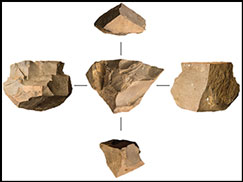Crossref Citations
This article has been cited by the following publications. This list is generated based on data provided by
Crossref.
Tryon, Christian A.
and
Ranhorn, Kathryn L.
2020.
Culture History and Convergent Evolution.
p.
143.
Agam, Aviad
2020.
Late lower paleolithic lithic procurement and exploitation strategies: A view from Acheulo-Yabrudian Qesem Cave (Israel).
Journal of Archaeological Science: Reports,
Vol. 33,
Issue. ,
p.
102447.
Rusch, Neil
2021.
Rhythms of time and place.
Hunter Gatherer Research,
Vol. 7,
Issue. 3-4,
p.
233.
Hussain, Shumon T.
and
Will, Manuel
2021.
Materiality, Agency and Evolution of Lithic Technology: an Integrated Perspective for Palaeolithic Archaeology.
Journal of Archaeological Method and Theory,
Vol. 28,
Issue. 2,
p.
617.
Pazan, Kyra R.
Dewar, Genevieve
and
Stewart, Brian A.
2022.
The MIS 5a (~80 ka) Middle Stone Age lithic assemblages from Melikane Rockshelter, Lesotho: Highland adaptation and social fragmentation.
Quaternary International,
Vol. 611-612,
Issue. ,
p.
115.
Gregory, Alex
Mitchell, Peter
and
Pargeter, Justin
2023.
Raw Material Surveys and Their Behavioral Implications in Highland Lesotho.
Journal of Paleolithic Archaeology,
Vol. 6,
Issue. 1,
Mesfin, Isis
Benjamim, Maria-Helena
Lebatard, Anne-Elisabeth
Saos, Thibaud
Pleurdeau, David
Matos, Jorge
Lotter, Matt
and
Petraglia, Michael D.
2023.
Evidence for Earlier Stone Age ‘coastal use’: The site of Dungo IV, Benguela Province, Angola.
PLOS ONE,
Vol. 18,
Issue. 2,
p.
e0278775.
Mesfin, Isis Isabella
2024.
The Knapping of Quartz Crystals during the Later Stone Age at Matupi Cave, Ituri Province, Democratic Republic of Congo.
Lithic Technology,
Vol. 49,
Issue. 1,
p.
41.
Thiry, Médard
and
Milnes, Anthony
2024.
Engineered ‘landmarks’ associated with Late Paleolithic engraved shelters.
Journal of Archaeological Science: Reports,
Vol. 55,
Issue. ,
p.
104490.
